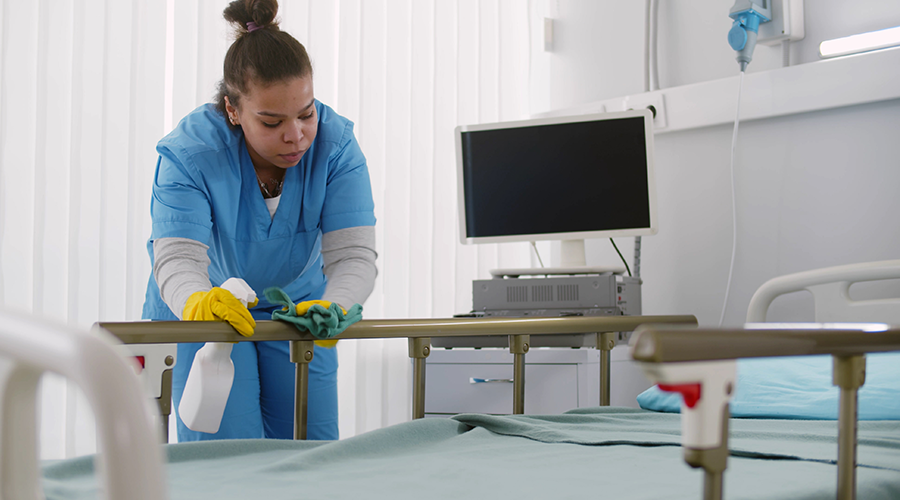Each day environmental services (EVS) teams are tasked with cleaning patient rooms. On average, they spend 15-20 minutes in an occupied patient room collecting trash and dirty linens and cleaning the patient room and bathroom.
Routine cleaning and removal of soil from environmental surfaces in patient rooms is an accepted practice, but accomplishing this task daily might be difficult for EVS personnel, especially when the room is occupied. Cleaning personnel face several challenges that can compromise the effectiveness of their cleaning.
“First of all, the severity of patient illness sometimes makes it difficult to do thorough cleaning," says Mary Brachman, an infection control consultant. "It is a very busy environment. The number of doctors and nurses and the amount of hands-on care that is being delivered makes access to the patient's bedside difficult."
The amount and complexity of medical equipment also can impede access to surfaces, particularly those most likely to be contaminated. EVS personnel often must maneuver around ventilator tubing, EKG wires and IV poles and tubing that go over the bedrail. The process also is compounded by the fact that in some hospitals, EVS personnel are told not to touch the patient's medical equipment.
Surfaces frequently get re-contaminated after EVS personnel have cleaned the patient's room. Bedrails can become contaminated by the gloved hands of the healthcare workers during the course of the day.
Holding someone accountable for cleaning poses yet another challenge. Perhaps certain surfaces have never been clearly identified as the responsibility of an individual, or maybe there has been a break in communication on accountability. Although the solution to these challenges might vary among hospitals, these suggestions can help managers address problems:
Develop a team approach to cleaning that includes representatives from environmental services, nursing and infection control.
Achieve consensus on the role of the environment in the spread of infection. The risk might vary according to the type of hospital and patient population.
Identify surfaces that become contaminated and the likely timing of the contamination.
Determine the frequency of cleaning for each surface, and look at methods used to clean the surfaces, including the types of disinfectants and cleaning practices.
Identify the person responsible for cleaning specific surfaces. In some areas, cleaning might be a shared responsibility with nursing personnel, since EVS typically cleans rooms only daily, and surface re-contamination might occur during patient care. Some hospitals have placed ready-to-use disinfectant wipes in areas where surface contamination is frequent, such as the ICU, so they are convenient for patient care aids and nurses to use when surface contamination occurs.
Educate personnel on the role of the environment in the spread of infection, proper cleaning methods and the healthcare workers' responsibilities to reduce risk of infection.
Monitor compliance. Compliance monitors might include training, appropriate disinfectant use, including type and concentration, and appropriate surfaces cleaned. Managers also must use caution when drawing conclusions about cleaning practices using environmental monitors because other factors, such as severity of patient illness, antibiotic use, barrier precautions and hand hygiene, might be contributing factors.
J. Darrel Hicks, BA, MESRE, CHESP, Certificate of Mastery in Infection Prevention, is the past president of the Healthcare Surfaces Institute. Hicks is nationally recognized as a subject matter expert in infection prevention and control as it relates to cleaning. He is the owner and principal of Safe, Clean and Disinfected. His enterprise specializes in B2B consulting, webinar presentations, seminars and facility consulting services related to cleaning and disinfection. He can be reached at darrel@darrelhicks.com, or learn more at www.darrelhicks.com.

 Grounding Healthcare Spaces in Hospitality Principles
Grounding Healthcare Spaces in Hospitality Principles UC Davis Health Selects Rudolph and Sletten for Central Utility Plant Expansion
UC Davis Health Selects Rudolph and Sletten for Central Utility Plant Expansion Cape Cod Healthcare Opens Upper 2 Floors of Edwin Barbey Patient Care Pavilion
Cape Cod Healthcare Opens Upper 2 Floors of Edwin Barbey Patient Care Pavilion Building Sustainable Healthcare for an Aging Population
Building Sustainable Healthcare for an Aging Population Froedtert ThedaCare Announces Opening of ThedaCare Medical Center-Oshkosh
Froedtert ThedaCare Announces Opening of ThedaCare Medical Center-Oshkosh